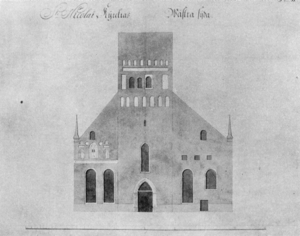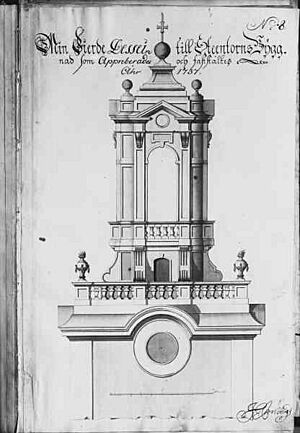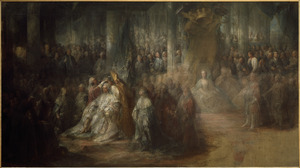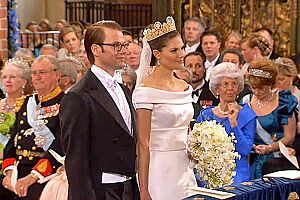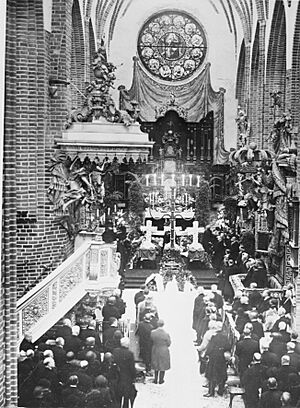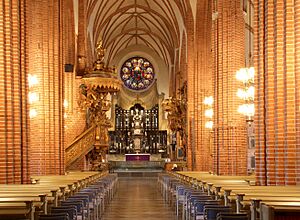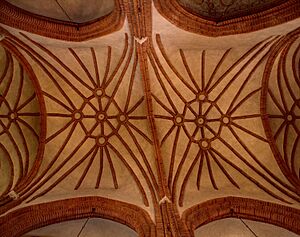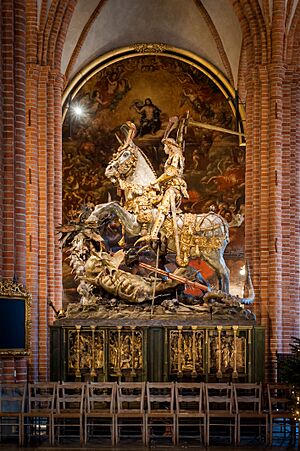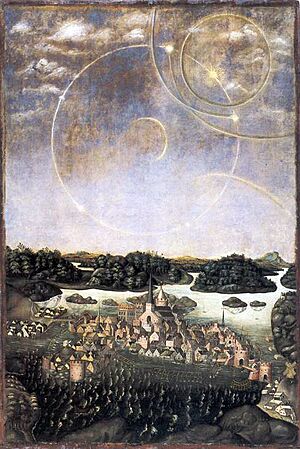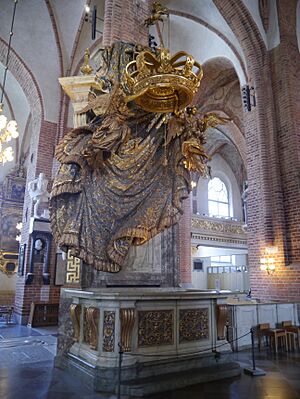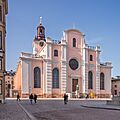Storkyrkan facts for kids
Quick facts for kids Storkyrkan |
|
|---|---|
|
Stockholms domkyrka
Sankt Nikolai kyrka |
|
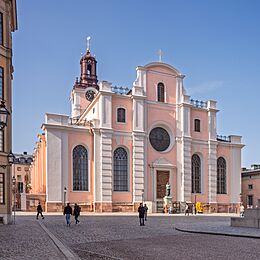
East facade of Storkyrkan, facing Slottsbacken
|
|
| 59°19′33″N 18°04′14″E / 59.32583°N 18.07056°E | |
| Location | Stockholm |
| Country | Sweden |
| Denomination | Church of Sweden |
| Previous denomination | Roman Catholic |
| Website | Website of Storkyrkan |
| History | |
| Status | Active |
| Founded | 13th century |
| Dedication | Saint Nicholas |
| Consecrated | 1306 |
| Architecture | |
| Functional status | Cathedral & Parish church |
| Specifications | |
| Length | 63 metres (207 ft) |
| Width | 37.2 metres (122 ft) |
| Height | 60.4 metres (198 ft) (to the top of the tower) |
| Administration | |
| Diocese | Stockholm |
Storkyrkan (which means "The Great Church" in Swedish) is the oldest church in Stockholm, Sweden. It is also known as Stockholms domkyrka (Stockholm Cathedral) or Sankt Nikolai kyrka (Church of Saint Nicholas). You can find it right in the middle of Stockholm's old town, Gamla stan. It sits between the Stockholm Palace and Stortorget, the city's historic main square.
The church was officially opened in 1306 and was dedicated to Saint Nicholas. However, people believe that building the church started even earlier, in the 1200s. Inside, Storkyrkan still looks much like it did in the Middle Ages. It has a high, arched ceiling supported by strong brick pillars. But from the outside, the church looks very different. It has a Baroque style, which came from big changes made in the 1700s.
Storkyrkan was very important during the Reformation in Sweden. This was a time when Sweden changed from being Roman Catholic to Lutheran. It was the first place where church services (called Mass) were held in Swedish instead of Latin. Today, Storkyrkan is the main church for the Bishop of Stockholm. It became a cathedral when the Diocese of Stockholm was created in 1942.
For a long time, Storkyrkan was Stockholm's only church for regular people. It also had strong ties to the Swedish royal family. Many important historical events happened here. For centuries, it was used for the coronation of kings and queens. More recently, the wedding of Crown Princess Victoria and Daniel Westling took place here in 2010. The church is still used for important events, like funerals for famous people such as the writer Astrid Lindgren.
Inside Storkyrkan, you can see many amazing artworks and decorations. These include a medieval sculpture of Saint George and the Dragon. There is also the Vädersolstavlan, a painting that shows one of the earliest pictures of Stockholm.
Contents
Where is Storkyrkan Located?

Storkyrkan is Stockholm's oldest church. It was built right in the center of the medieval city. It sits on the highest point of Gamla stan, between the Stock Exchange Building and Stockholm Palace. The church, along with the palace and Stortorget, formed the heart of early Stockholm.
While the inside of the church still looks medieval, the outside was mostly changed in the 1700s. Storkyrkan is part of a group of Baroque buildings around the Royal Palace. These include the Axel Oxenstierna palace and Slottsbacken with its obelisk. People say it's an "irreplaceable" part of Stockholm's look.
The church is surrounded by streets on three sides. A courtyard is located just south of the church. Two small buildings, designed by Erik Palmstedt in 1767, are part of this courtyard. They were built as the church's burial chapel and coach-house. The courtyard has walls with wrought iron gates. The posts of the west gate still have statues from 1675. These statues likely represent Reason and Divine Love.
Next to the east side of the church, there is a statue of the Swedish reformer Olaus Petri. It was put there in 1898. On the ground near the east side, you can also see lines that show where an old church choir used to be. This part was taken down during the time of King Gustav Vasa.
The Church Building's History
Medieval Beginnings
The first mention of a church in Stockholm was in 1279. The city church was officially opened in 1306. This makes Storkyrkan the oldest church in Stockholm. The early history is a bit unclear. Stockholm was founded in the mid-1200s, so it's likely there was a church before 1306. Some traditions say Birger Jarl founded the church.
The oldest parts of the current building probably date back to the church opened in 1306. During the entire Middle Ages, the church's main patron saint was Saint Nicholas. Many churches in the Baltic region from the 1200s were dedicated to Saint Nicholas. This was common in cities where the Hanseatic League was active, like Stockholm. Storkyrkan was the only church for the whole city until the 1590s.
The medieval history of the church is complex. There are not many old written records. Also, a lack of decorations makes it hard to guess the age of different parts. Originally, the church had a main nave and two side aisles. It had a wooden ceiling supported by six pillars. The church was built using brick.
The church was rebuilt and made bigger many times during the 1300s and 1400s. Making the church more beautiful was a way for both Swedish kings and Stockholm's citizens to show their power.
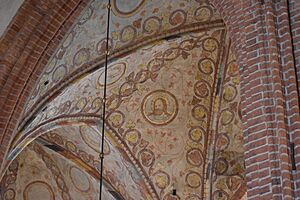
Around 1346, the first of many chapels was added to the church. This happened after a gift from King Magnus IV and his wife Blanche of Namur. This chapel was for Saint Mary and was on the south side of the church's east end. You can still see the four sections (called bays) that belonged to this chapel inside Storkyrkan. This chapel had Early Gothic murals.
More chapels were added in the 1300s and early 1400s. By the end of the Middle Ages, Storkyrkan had over 30 chapels or special altarpieces. This was a huge number, similar to the biggest cathedrals in medieval Sweden. The church grew piece by piece as these chapels were added. Another set of murals, painted by Albertus Pictor, was added in the 1400s.
Between 1474 and 1496, a major rebuilding project took place. All these chapels were joined into one large space. New vaults were put in, creating a high, even ceiling. The church was also made much longer towards the east. A choir section was added, but it was later taken down in the 1500s. The church tower was also built in the early 1400s. It was first meant to be a defense tower. By the end of the 1400s, Storkyrkan had its basic shape and size that it still has today.
Reformation and Later Changes
In the 1500s, the Reformation in Sweden brought big changes. Catholicism was replaced by Lutheranism. The government took much of the church's property, including silver from the chapels. While Sweden did not have much iconoclasm (destruction of religious images), some Catholic sculptures in Storkyrkan were damaged.
When Christian II of Denmark was in Stockholm in 1520, the church was made stronger. This showed the political tensions that led to the Stockholm Bloodbath in 1521. Adam van Düren worked on these changes. He also made a sculpture with a male and female lion and an eel. This sculpture has a funny, unclear message. More changes were made to the pillars, vaults, and walls during the reign of King John III. These changes helped make the inside of the church look more unified.
Changes in the 1700s
In the 1700s, the outside of Storkyrkan changed a lot. Its medieval look was completely replaced with a Baroque style. Nicodemus Tessin the Younger had suggested updating the facade. In 1736, Johan Eberhard Carlberg was hired to fix the church tower. Soon, this job grew into a full makeover of the outside and a new tower spire.
Both Carlberg and Carl Hårleman, the Royal Palace architect, quickly made many designs for a new spire. This showed that modernizing the church's exterior had been thought about for a while. Hårleman especially wanted the church to match the palace's style. The two architects argued that each other's designs had technical problems. In the end, Carlberg's fourth design for the spire was chosen. It was a mix of his and Hårleman's ideas. Carlberg also designed the other changes to the facade. This transformation from a Gothic to a Baroque building happened between 1736 and 1745. The church's exterior today still looks mostly like Carlberg's work.
Later in the same century, architect Erik Palmstedt redesigned the south side of the church courtyard in 1777. This was connected to the building of the stock exchange on Stortorget. He also designed the stairwell on the south side of the tower, which was finished in 1778. These additions made the church and its surroundings look more Classical, moving away from its medieval roots. King Gustav III of Sweden even wanted to tear down the whole church and build a new one inspired by the Pantheon in Rome.
Recent History
In the 1860s, the windows got new wrought iron decorations in a Neo-Gothic style. More changes were made in the late 1800s, especially to make the church safer from fire. A bigger renovation happened from 1903 to 1909, led by architect Ernst Stenhammar. During this time, the white paint covering the brick pillars and walls was removed. Since then, the inside has shown the bare brick. This was an attempt to make it look more "medieval," but the interior was probably always painted white. Another big renovation took place from 1952 to 1954. The church became a cathedral for the new Diocese of Stockholm in 1942.
Royal Connections and Historical Events
Storkyrkan has been the site of many important events in Swedish history. Stockholm's growing wealth and the church's closeness to the Royal Palace caught the attention of both the Archbishop of Uppsala and the Swedish kings. The archbishop sometimes sent a special representative to the church.
The Reformation in Sweden partly began in Storkyrkan. It was here that Lutheranism was first preached publicly in Sweden. Storkyrkan was also the first church in Sweden where Mass was held in Swedish, in 1525. Olaus Petri, a main supporter of the Reformation, was a priest at Storkyrkan then. After this, Storkyrkan was used only by Swedish-speaking people. The German and Finnish-speaking groups moved to other churches.
The church has been used for the coronation of Swedish kings and queens many times. The first royal coronation in Storkyrkan was for King Magnus IV and Queen Blanche of Namur in 1336. Most medieval coronations happened in Uppsala Cathedral. The next coronation in Storkyrkan was in 1497, for King John during the Kalmar Union. His son, Christian II of Denmark, was crowned here on November 4, 1521. This ceremony was meant to show Sweden's submission to King Christian. Just a few days later, the Stockholm Bloodbath took place.
For a while, people thought it was bad luck for kings to be crowned in Storkyrkan. However, the wedding of King Eric XIV of Sweden and Karin Månsdotter happened here in 1568. Her coronation followed the wedding. Maria Eleonora of Brandenburg was also crowned Queen of Sweden in Storkyrkan in 1620. After a 130-year break, Queen Christina was crowned here in 1650. King Charles XII chose Storkyrkan for his coronation in 1697. King Frederick I was also crowned here in 1720. From then on, all Swedish monarchs, except Gustav IV Adolf, were crowned in Storkyrkan. The last coronation was for King Oscar II in 1873.
The church has also hosted royal weddings many times. Two of King Gustav Vasa's daughters were married here. The wedding of the future King Oscar I and Josephine of Leuchtenberg took place in Storkyrkan in 1823. Many other royal family members were married here in the 1800s and 1900s. In 2010, Storkyrkan was the place for the wedding of Victoria, Crown Princess of Sweden, and Daniel Westling.
Storkyrkan was rarely used for royal burials. That role belonged to Riddarholmen Church until 1950. However, many important funerals have taken place in Storkyrkan in the 1900s. In 1930, the funeral for the three members of the failed Andrée's Arctic balloon expedition was held here. More recently, the funerals of writer Astrid Lindgren (who passed away in 2002) and Sara Danius (who passed away in 2019) were also held in Storkyrkan.
When the MS Estonia sank in 1994, a memorial service was held in Storkyrkan. The royal family and the Prime Minister of Sweden attended. Similarly, the church held a special service after the assassination of foreign minister Anna Lindh in 2003.
Storkyrkan has also been used for other public events. Several military victories were celebrated publicly in the church during the time of the Swedish Empire. The biggest celebration was probably for the victory at the Battle of Narva (1700). Victories at Pułtusk (1703), Thorn (1703), and Svensksund (1790) were also celebrated here. During the time of the Riksdag of the Estates, the clergy (church leaders) usually met in Storkyrkan. Even today, a sermon in Storkyrkan traditionally marks the opening of the Riksdag (Swedish Parliament) every autumn. In the Middle Ages, the church was also used for meetings of Stockholm's city council.
Church Architecture
Outside Look
The church is built from brick. Its base is made stronger with sandstone and granite. Storkyrkan is not huge; it is 63 metres (207 ft) long and 37.2 metres (122 ft) wide. The outside of the church is all in the Baroque style. Only the stairwell added by Palmstedt has a slightly different look. The north and south sides have buttresses that look like flat pillars. The tower and the gables (pointed parts of the roof) are decorated with flat pillars and moldings.
At the southeast corner, a sundial from the 1500s is on the wall. A large memorial plaque with Latin writing is in the middle of the east wall. It remembers the church's rebuilding in the 1700s. There are 28 windows that let light into the church. The main entrance is at the base of the tower on the west side. Another entrance is on the north wall, and two smaller ones are on the south.
Inside Look
Storkyrkan is a hall church. This means its main space is wide and long, with a high ceiling. It has five sections across and eight sections long. The church's shape is a bit uneven because it had to fit around existing streets. Brick vaults, supported by pillars, cover the entire inside. The eight central sections have complex rib vaults. The rest of the church has simpler groin vaults.
The inside space is divided by the central nave, with open benches on both sides. The choir floor is three steps higher than the rest of the church. It is separated by wrought iron fences. Three balconies are in the west part of the church. One of these holds the church organ. Most windows are clear, but the northwest window has stained glass made by Einar Forseth in the 1900s. The stained glass rose window in the east wall was given to the church in 1858. It was made in France.
Church Furnishings and Art
Main Altarpiece
Storkyrkan's main altarpiece is called the "silver altarpiece." It was given to the church in 1652 by Margareta Pedersdotter. The altarpiece has a middle part and two side wings. The wings were made a bit later than the middle section. This Baroque altarpiece was made in Hamburg, Germany. It is crafted from ebony wood and silver.
The central part has three levels above a base (called a predella). On top is a small statue of Christ. Each level has a silver relief (a sculpture that sticks out from a flat surface). From bottom to top, these reliefs show the Crucifixion, the Entombment, and Christ in the realm of the dead. The relief on the predella shows the Last Supper. The Crucifixion relief is the largest. Its design might have been inspired by a painting by Peter Paul Rubens. Statues of Moses and John the Baptist stand next to the Crucifixion panel. The other panels are flanked by the Four Evangelists.
In the Middle Ages, the church had many other altarpieces. Some of these are now in other places. For example, an altarpiece now in Boglösa Church was made for Storkyrkan in the 1400s. Another one, now in Jäder Church, also came from Storkyrkan. A third altarpiece, made in Lübeck in 1468, is now in the Swedish History Museum.
Saint George and the Dragon Sculpture
North of the choir, there is a large, late medieval statue of Saint George and the Dragon. It shows the saint on horseback fighting the dragon. This sculpture is about 3.5 metres (11 ft) tall. A smaller group of figures shows the princess Saint George is saving, along with the symbolic Lamb of God. The base of the statue has scenes from the legend of Saint George.
Regent Sten Sture the Elder ordered this sculpture. It was meant to be a monument for him and his wife. He ordered it after his victory over Danish troops at the Battle of Brunkeberg in 1471. Sten Sture had prayed to Saint George for help during the battle. The sculpture was officially revealed in 1489. It doesn't have a signature, but most people believe it was made by Bernt Notke. The sculpture was likely meant to be not just a religious artwork, but also a political and personal monument to Sten Sture and his victory.
Other Medieval Items
The church also has a crucifix, possibly made by Notke or someone who worked like him. This crucifix is made of oak wood and used to be painted in many colors. It was probably made between 1475 and 1500. A large cross from around 1400 used to be in Storkyrkan. It is now at the Museum of Medieval Stockholm.
The church's baptismal font was made in 1514. It is made of limestone from Uppland. It is similar to other baptismal fonts found in central and northern Sweden.
A tall, seven-branched bronze candelabrum (a large candle holder) belongs to the church. It is about 370 centimetres (150 in) tall. It was probably made in the late 1400s. It has lion sculptures at its base and two human faces on its shaft. Such candelabra are rare in Sweden but more common in Germany, where this one was likely made.
In 1564, the helmet and spurs of Saint Olaf were displayed in Storkyrkan. These are the oldest war trophies taken by Swedish troops. In the 1860s, they were moved to the Swedish History Museum.
Vädersolstavlan Painting
The oldest known color picture of Stockholm is the Vädersolstavlan (The sun dog painting). Olaus Magnus gave it to the church in 1535. It was painted by Urban målare. The painting you see today is a copy from 1636, made by Jacob Heinrich Elbfas. It seems to be a very accurate copy. The painting shows Stockholm as it looked in the early 1500s. Above the city, it shows a sun dog, which is a natural light phenomenon. This was seen over Stockholm on April 20, 1535. The painting was cleaned and fixed in 1998–99.
Other Paintings
Storkyrkan has two huge paintings by David Klöcker Ehrenstrahl: The Crucifixion and The Last Judgment. They were painted in 1695 and 1696. They were first meant for the Royal Chapel at Tre Kronor Castle. But they were saved from the fire that destroyed the castle. Instead, they were put in Storkyrkan. The Crucifixion is 7.4 metres (24 ft) tall, and The Last Judgment is over 10 metres (33 ft) tall.
Among other paintings, there is an epitaph (a monument for the dead) taken as war loot from Frombork in 1626. There is also a 17th-century Russian icon of Saint Nicholas. It was probably made in Moscow. Swedish troops took it after a battle in 1703, and General Carl Magnus Stuart gave it to the church.
Royal Pews and Pulpit
The church's pulpit (where the preacher stands) is attached to a pillar on the north side of the nave. Burchard Precht designed and built it between 1698 and 1702. It is made of gilded wood and has decorations and reliefs. One section east of the pulpit are the two royal pews. One is on the north side and the other on the south. They have two parts. The lower part is a seating area with a decorated wooden barrier. Originally, a throne was in each pew. The upper part of each pew is a gilded wooden canopy. It looks like a huge royal crown carried by angel sculptures.
These royal pews were for the royal family. Nicodemus Tessin the Younger designed them, and Burchard Precht built them.
Graves and Memorials
Until the 1800s, being buried inside the church was considered very important. This meant the church became very crowded with graves. Storkyrkan still has many decorated graves and other memorials. Among the most detailed are the graves of the family of Jesper Mattson Cruus af Edeby and the grave of Johan Adler Salvius. There are also many memorial plaques on the walls. One of the more recent ones remembers Nicodemus Tessin the Elder, Nicodemus Tessin the Younger, and Carl Gustav Tessin. It was made by sculptor Carl Milles.
Votive Ship
One of the oldest votive ships (a model ship given as an offering) in the world came from Storkyrkan. It dates from the 1600s. Today, it is kept in the Maritime Museum in Stockholm. A copy of it hangs in the church.
Music at Storkyrkan
The organ in Storkyrkan was built in 1960 by Marcussen & Søn in Denmark. The front of the organ was designed in 1789.
The church has been used for concerts since the late 1700s. Today, the church has four choirs. One of them, Storkyrkans Gosskör (Storkyrkan's Boys Choir), has been around since the 1600s. At least three organists of Storkyrkan were also composers: Andreas Düben (around 1597/98–1662), Ferdinand Zellbell the Younger (1719–1780), and Harald Fryklöf (1882–1918).
Images for kids
-
Storkyrkan visible at the end of Slottsbacken from across the water. The church is part of a coherent ensemble of Baroque architecture surrounding Stockholm Palace.
-
Medieval vault paintings from c. 1346 (later restored) in what used to be the first chapel of the church, dedicated to Saint Mary.
-
The coronation of King Gustav III in Storkyrkan in 1772, painting by Carl Gustaf Pilo
See also
 In Spanish: Catedral de San Nicolás (Estocolmo) para niños
In Spanish: Catedral de San Nicolás (Estocolmo) para niños


